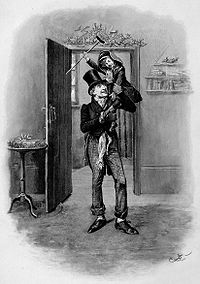Clerk
The examples and perspective in this articledeal primarily with the United States and do not represent aworldwide viewof the subject.(February 2012) |

Aclerkis awhite-collar workerwho conductsrecord keepingas well as general office tasks, or a worker who performs similar sales-related tasks in aretailenvironment. The responsibilities ofclerical workerscommonly includerecord keeping,filing, staffing service counters, screening callers, and other administrative tasks.[1]InCity of Londonlivery companies,the clerk is thechief executive officer.
History and etymology
[edit]The wordclerkis derived from the Latinclericusmeaning "cleric"or"clergyman",which is thelatinisationof theGreekκληρικός(klērikos) from a word meaning a "lot" (in the sense of drawing lots) and hence an "apportionment" or "area of land".[2][3]
The association derived from medieval courts, where writing was mainly entrusted toclergybecause mostlaymencould not read. In this context, the wordclerkmeant "scholar".Even today, the termclerk regulardesignates a type of cleric (one living life according to arule). The cognate terms in some languages, notablyKlerkin Dutch, became – at the end of the nineteenth century – restricted to a specific, fairly low rank in theadministrativehierarchy.
United States
[edit]

Clerical workers are the largest occupational group in theUnited States.In 2004, there were 3.1 million general office clerks,[4]1.5 million office administrative supervisors and 4.1 million secretaries.[5]Clerical occupations often do not require a college degree, though some college education or 1 to 2 years in vocational programs are common qualifications. Familiarity with office equipment and certain software programs is also often required. Employers may provide clerical training.[6]In 2006, the median salary for clerks was $23,000, while the national median income for workers age 25 or older was $33,000.[7]Median salaries ranged from $22,770 for general office clerks to $34,970 for secretaries and $41,030 for administrative supervisors. Clerical workers are consideredworking classby Americansociologistssuch as William Thompson, Joseph Hickey or James Henslin as they perform highly routinized tasks with relatively little autonomy.[8]SociologistDennis Gilbert,argues that the white and blue collar divide has shifted to a divide between professionals, including some semi-professionals, and routinized white collar workers.[9]White collar office supervisors may be consideredlower middle classwith some secretaries being located in that part of the socio-economic strata where the working and middle classes overlap.
See also
[edit]- Clerks (film)
- Clerk baronets
- Clerk family
- Clerk (surname)
- Clerk of works
- Court clerk
- Law clerk
- Legal clerk
- Barristers' clerk
- Lord Justice Clerk
- Patent clerk
- Municipal clerkor town clerk
- Clerk in holy orders
- Receptionist
- Pink collar
- Secretaries
References
[edit]- ^"Merriam Webster, definition of clerical worker".Retrieved2007-06-07.
- ^Clerk,Online Etymology Dictionary
- ^Klerikos,Henry George Liddell, Robert Scott, "A Greek-English Lexicon", at Perseus
- ^"US Department of Labor, General office clerks".Retrieved2007-06-07.
- ^"US Department of Labor, Secretaries and administrative assistants".Retrieved2006-06-07.
- ^"US Department of Labor, training of secretaries".Retrieved2007-06-07.
- ^"U.S. Census Bureau, personal income distribution, age 25+, 2006".Archived fromthe originalon 2007-03-19.Retrieved2007-06-07.
- ^Thompson, William; Joseph Hickey (2005).Society in Focus.Boston, MA: Pearson.ISBN0-205-41365-X.
- ^Gilbert, Dennis (1998).The American Class Structure.New York: Wadsworth Publishing.ISBN0-534-50520-1.
